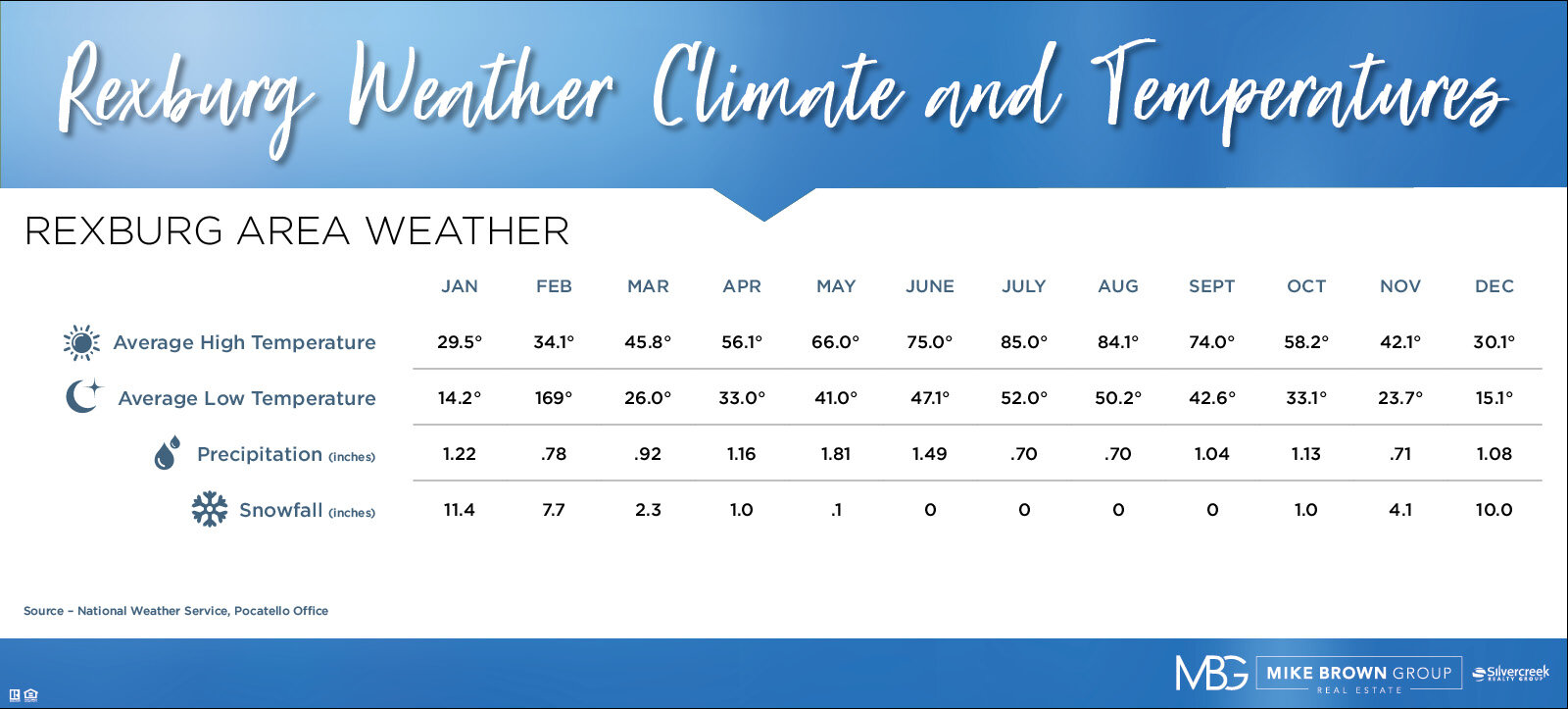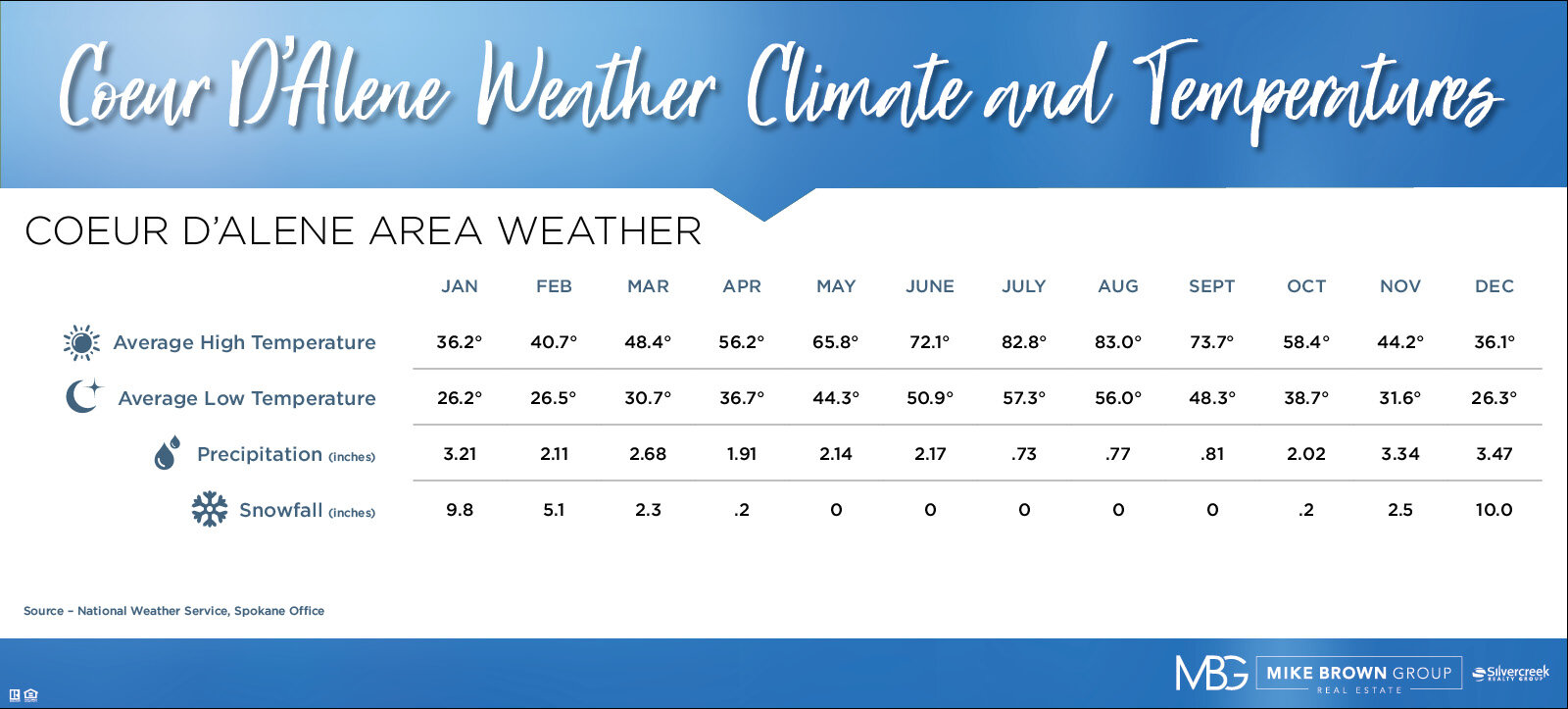What is the weather like in Idaho? A common question, especially from people who are looking at buying Idaho real estate. Idaho is home to four distinct seasons, which is fantastic for people who enjoy all types of outdoor recreation.
To understand the weather in Idaho, we first need to look at the various climates that Idaho has, as determined by the state’s geography and topography.
Climates in Idaho include cold semi-arid, warm, humid continental, humid subtropical, hot, humid continental, subarctic, and hot summer Mediterranean.
In reality, eastern Idaho and the northern part of the Gem state get more precipitation than the Boise area in the southwestern part of the state. Southwestern Idaho is also warmer on average than the other areas we’ll discuss shortly.
Let’s take a tour of some of the climate zones in Idaho, checking in first on the state capital of Boise.
Boise Weather
The Boise metropolitan area, also known as the Treasure Valley, is located in the Snake River Valley of southwestern Idaho. The location is rimmed by the Boise Mountains to the north and the Owyhee Range to the southwest. The Cascade and Blue Mountain Ranges in Oregon and Washington affect air masses that move east, creating a rain shadow, especially in the Boise area. The Rocky Mountains to the east help shield the area from cold air plunging south from Canada during the winter months.

Boise and the Treasure Valley reside in a cold semi-arid climate zone, with the area receiving somewhere between 10 inches and 15 inches of precipitation annually. The site is essentially high desert; however, it does have lush landscaping and isn’t a barren moonscape like many other deserts.
Because of the dry climate, the Boise area regularly sees diurnal temperature variation (the difference between the daytime high and the nighttime low temperature) exceeding 30 degrees during the summer months. Speaking of summertime temperatures, the Boise area sees daytime highs over 90 degrees about 60 days out of the year and cracking 100 degrees eight days a year on average. Hot temperatures don’t usually arrive in the area until July, lasting through the end of August. Occasionally, temperatures will remain above 90 degrees the first couple of weeks of September, but not usually.
Rainfall during the summer is infrequent as the summer months are usually hot and dry.
The spring and fall seasons in the Boise area are mild, with fall lasting what seems like a few weeks and spring being more gradual, warming slowly. As the temperatures fall, precipitation starts to increase in September, with additional moisture finding its way to the valley through May. December, January, and May are the wettest months on average for the Boise area.
The springtime weather in Boise can be dynamic, as warm moist air meets cold, dry air, causing an opportunity for thunderstorms to rumble across the area. Sometimes, the storms can be severe, producing gusty winds and hail but rarely producing tornadoes.
Winter usually brings snow to the region, especially in the higher elevations. Boise and the Treasure Valley typically see between 18 inches and 20 inches of snow annually, well below the national average.
The Boise area also has another interesting phenomenon called an “inversion,” which occurs during the cold winter months. Cold air gets trapped in the valley with warm air aloft, creating stagnant air that traps cool air, fog, etc. Inversions can last for a day or two upwards of a couple of weeks. In nearby ski resorts with views of the valley, it makes for an interesting visual, with the inversion appearing like a blanket covering the valley.
For the entire year, Boise’s high-temperature average is 62 degrees with a low of 41 degrees.
While Boise is Idaho’s most populated city, other cities across the state have weather worth discussing. Let’s travel east to the town of Rexburg
Rexburg Weather
Rexburg, located in eastern Idaho, is a college town that serves as the home of BYU Idaho.
With the southwestern part of Idaho getting limited amounts of precipitation annually, that isn’t the case in eastern Idaho. Rexburg is also home to temperature extremes and sees considerably more moisture annually than Boise, especially in the winter months. Rexburg generally sees nearly twice as much snow as Boise does during the winter season, checking in with about 40 to 42 inches of snow.

During the summer, Rexburg sees average high temperatures in the mid-80s. Occasionally, the summertime temperatures can crack 90 degrees, but rarely.
Now, let’s travel to the northwestern part of the state to Coeur d’Alene, which is in yet another different climate zone in Idaho.
Coeur d’Alene Weather
The city of Coeur d’Alene is in the northern part of Idaho and is a beacon for tourism. Due to its location, the area sees much more moderate temperatures as well as more precipitation annually. It rarely experiences temperatures above 90 degrees, usually around 13 days per year. Temperatures over 100 degrees are even rarer.
The region typically sees its first freeze in mid-October and its last freeze coming in early May. Several days of temperatures lower than 10 degrees are not uncommon.

Because of its location, Coeur d’Alene gets a lot more moisture as it’s located on the windward side of the Rocky Mountains, so it is affected by storms that originate in the Pacific that push inland. It also is affected by fronts that move south out of Canada to the north. Its proximity to Lake Coeur d’Alene also moderates the city’s temperatures.
The region gets nearly 70 inches of snow per year, nearly doubling the amount Rexburg receives. It also receives plenty of precipitation in the form of rain, getting at least three-quarters of an inch of rain during its driest month of July. Like other Idaho cities, rainfall in the area drops considerably during July and August.
The Last Word
So, what is the weather like in Idaho? As you can see, it varies significantly from region to region. Idaho is growing and is one of the fastest-growing states in the nation. It stands to reason that its relatively mild weather with abundant recreational activities is attractive to prospective and current residents.


